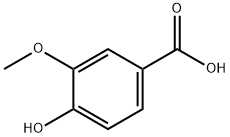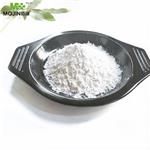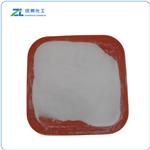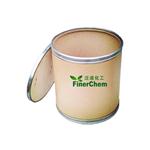Description
Vanillic acid is a dihydroxybenzoic acid that can be used as a flavoring agent. As an oxidized form of vanillin, it is the intermediate product during the two-step bioconversion process from ferulic acid to vanillin. It exists in high amount in the root of Angelica sinenisis, which is a plant used in traditional Chinese medicine. It also exists in acal oil, argan oil as well as wine and vinegar. It can be used in the synthesis of the analeptic drug etamivan, modecainide, brovanexine, vanitiolide, and vanyldisulfamide. It can be manufactured through the oxidation of vanillin to the carboxylic acid.
References
https://en.wikipedia.org/wiki/Vanillic_acid
https://pubchem.ncbi.nlm.nih.gov/compound/Vanillic_acid#section=Top
Chemical Properties
white odourless crystals or powder
Chemical Properties
4-Hydroxy-3-methoxybenzoic acid has a vanilla-like odor and taste.
Occurrence
Reported found in guava, grape, brandy, rum, whiskey, sherry, red and white wines, Scotch and Canadian
whiskey, pork (fried), cocoa, peanuts (raw), mushrooms, guava fruit, mangos (fresh), wort, vanilla and black chokeberries.
Uses
Vanillic acid is used as a flavoring agent in food. It acts as an intermediate in the production of vanillin from ferulic acid. Further, it is used in wine and vinegar.
Uses
Vanillin, a compound widely used in foods, beverages, cosmetics and drugs, has been reported to exhibit multifunctional effects such as antimutagenic, antiangiogenetic, anti-colitis, anti-sickling, an
d antianalgesic effects. However, results of studies on the antioxidant activity of vanillin are not consistent.
Preparation
Prepared by bioconversion of ferulic acid by means of a vanillate-negative mutant of Pseudomonas fluorescens strain
BS13. Also prepared by whole-cell bioconversion of vanillin to vanillic acid by Streptomyces viridosporus
Definition
ChEBI: A monohydroxybenzoic acid that is 4-hydroxybenzoic acid substituted by a methoxy group at position 3.
Aroma threshold values
Aroma at 5.0%: weak vanilla, creamy, milky.
Taste threshold values
Taste characteristics at 100 ppm: weak sweet resinous vanilla, creamy with a smooth sweetness and body,
slightly chocolate-like with a spicy vanitrop nuance
Synthesis Reference(s)
Journal of the American Chemical Society, 68, p. 429, 1946
DOI: 10.1021/ja01207a025Organic Syntheses, Coll. Vol. 4, p. 972, 1963
General Description
Vanillic acid is one of the key aromatic volatile compounds of vanilla beans.
Biochem/physiol Actions
Taste at 100 ppm




